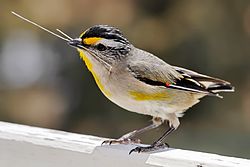Pardalotidae
| Pardalotes | |
|---|---|
 |
|
| Pardalotus striatus ornatus with nesting material | |
| Scientific classification | |
| Kingdom: | Animalia |
| Phylum: | Chordata |
| Class: | Aves |
| Order: | Passeriformes |
| Family: |
Pardalotidae Strickland, 1842 |
| Genus: |
Pardalotus Vieillot, 1816 |
| Species | |
Pardalotes or peep-wrens are a family, Pardalotidae, of very small, brightly coloured birds native to Australia, with short tails, strong legs, and stubby blunt beaks. This family is composed of four species in one genus, Pardalotus, and several subspecies. The name derives from a Greek word meaning "spotted". The family once contained several other species now split into the family Acanthizidae.
Pardalotes spend most of their time high in the outer foliage of trees, feeding on insects, spiders, and above all lerps (a type of sap-sucking insect). Their role in controlling lerp infestations in the eucalyptus forests of Australia may be significant. They generally live in pairs or small family groups but sometimes come together into flocks after breeding.
Pardalotes are seasonal breeders in temperate areas of Australia but may breed year round in warmer areas. They are monogamous breeders, and both partners share nest construction, incubation and chick-rearing duties. All four species nest in deep horizontal tunnels drilled into banks of earth. Externally about the size of a mouse-hole, they can be very deep, at a metre or more. Some species also nest in tree hollows.
The pardalotes consist of several species contained in a single genus, Pardalotus, with the general consensus being to recognise four species. The placement of the genus has varied, being first placed with the mostly oriental flowerpeckers (Dicaeidae), as both groups are dumpy-looking birds with bright plumage. In addition both groups have a reduced tenth primary (one of the flight feathers). Genetic analysis has shown that the two groups are in fact not closely related, and that the pardalotes are instead more closely related another Australian family, the Acanthizidae, which includes the scrubwrens, gerygones and thornbills. The two are sometimes merged into one family; when this is done the combined family is known as Pardalotidae, but the two groups are have also been treated as two separate families.
Within the family two species, the forty-spotted pardalote and the red-browed pardalote, are fairly invariant species, but the remaining two species are highly variable. The striated pardalote contains six subspecies, which are sometimes elevated to four separate species. The spotted pardalote has three subspecies, one of which—the yellow-rumped pardalote—is sometimes treated as a separate species due to its distinctive plumage and call and lack of zone of hybridization in southwestern Australia. Within the family the relationships between the subspecies are unclear, although it is thought that the forty-spotted pardalote is closely related to the spotted pardalote.
...
Wikipedia
